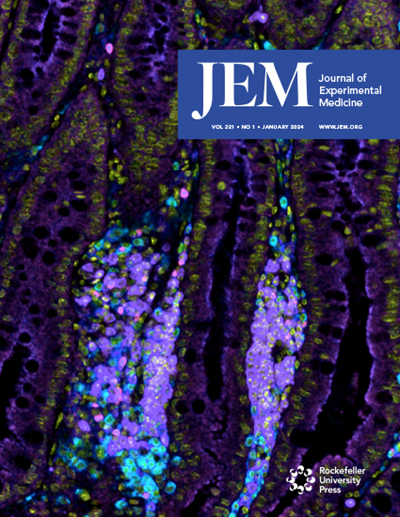大脑与眼睛的联系:不仅仅是动作电位
IF 12.6
1区 医学
Q1 IMMUNOLOGY
Journal of Experimental Medicine
Pub Date : 2024-11-04
Epub Date: 2024-10-10
DOI:10.1084/jem.20241519
引用次数: 0
摘要
在本期《实验医学杂志》(Journal of Experimental Medicine)上,Cao 等人(https://doi.org/10.1084/jem.20240386)证明,眼睛与大脑之间的联系并不局限于视神经传递的冲动,在阿尔茨海默病(AD)中,有毒 Aβ 从大脑流入视网膜是 AD 引起视网膜变性的基础。本文章由计算机程序翻译,如有差异,请以英文原文为准。
The brain-eye connection: More than just action potentials.
In this issue of the Journal of Experimental Medicine, Cao et al. (https://doi.org/10.1084/jem.20240386) demonstrate that the connection between the eye and the brain goes beyond the impulses carried by the optic nerve and that in Alzheimer's disease (AD), the influx of toxic Aβ from the brain to the retina underlies AD-induced retinal degeneration.
求助全文
通过发布文献求助,成功后即可免费获取论文全文。
去求助
来源期刊
CiteScore
26.60
自引率
1.30%
发文量
189
审稿时长
3-8 weeks
期刊介绍:
Since its establishment in 1896, the Journal of Experimental Medicine (JEM) has steadfastly pursued the publication of enduring and exceptional studies in medical biology. In an era where numerous publishing groups are introducing specialized journals, we recognize the importance of offering a distinguished platform for studies that seamlessly integrate various disciplines within the pathogenesis field.
Our unique editorial system, driven by a commitment to exceptional author service, involves two collaborative groups of editors: professional editors with robust scientific backgrounds and full-time practicing scientists. Each paper undergoes evaluation by at least one editor from both groups before external review. Weekly editorial meetings facilitate comprehensive discussions on papers, incorporating external referee comments, and ensure swift decisions without unnecessary demands for extensive revisions.
Encompassing human studies and diverse in vivo experimental models of human disease, our focus within medical biology spans genetics, inflammation, immunity, infectious disease, cancer, vascular biology, metabolic disorders, neuroscience, and stem cell biology. We eagerly welcome reports ranging from atomic-level analyses to clinical interventions that unveil new mechanistic insights.

 求助内容:
求助内容: 应助结果提醒方式:
应助结果提醒方式:


